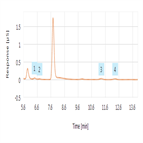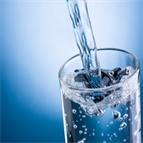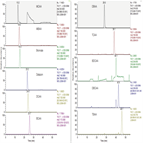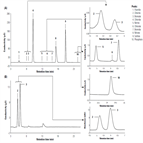Find methods for your needs
Refine by Feature
Displaying 1-5 of 24 results for Tag: Bromate
AN72209: Determination of Trace Concentrations of Oxyhalides and Bromide in Municipal and Bottled Waters
Instrument Type: ICTo demonstrate that oxyhalides and bromide can be successfully determined at concentrations required for regulatory standards and guidelines using a Thermo Scientific™ Dionex™ ion chromatography system equipped with a Thermo Scientific™ Dionex™ IonPac™ AS23-4μm column,Thermo Scientific™ Dionex™ CRD 300 Carbonate Removal Device, and a Thermo Scientific™ Dionex™ AERS™ 500 Carbonate Anion Electrolytically Regenerated Suppressor.
AU203: Determination of Trace Concentrations of Oxyhalides and Bromide in Municipal and Bottled Waters Using a Compact Ion Chromatography System
Instrument Type: ICTo demonstrate that oxyhalides and bromide can be run successfully using a Thermo Scientific™ Dionex™ Integrion™ HPIC™ system combined with a Thermo Scientific™ Dionex™ IonPac™ AS19-4μm column, featuring smaller resin particles, to achieve faster analysis without compromising data quality compared to using the Dionex IonPac AS19 column as in Application Note 167.
EPA Method 557 - Analysis of Haloacetic Acids, Dalapon, and Bromate in Drinking Water by IC-MS/MS
Instrument Type: ICMSHaloacetic acids (HAAs) are formed as disinfection byproducts when water is chlorinated to kill bacteria. Chlorine reacts with naturally occurring organic and inorganic matter in the water, such as decaying vegetation, to produce disinfection by-products (DBPs) that include HAAs. Of the nine species of HAAs, five are currently regulated by the U.S. Environmental Protection Agency (EPA). We demonstrate a simple and sensitive IC-MS/MS method for analyzing haloacetic acids, the pesticide dalapon, and bromate in water using EPA Method 557.
AN630: EPA Method 557 – Analysis of Haloacetic Acids, Dalapon, and Bromate in Drinking Water by IC-MS/MS: HAA9
Instrument Type: ICMSHaloacetic acids (HAAs) are formed as disinfection byproducts when municipal chlorination processes react with naturally occurring brominated and chlorinated species. Five HAAs are currently regulated, whereas four others may be included in future regulations. Here we demonstrate the determinations of 0.02 to 0.1 ng/L (ppt) HAA9 concentrations using ion chromatography separations combined with tandem MS on a triple quadrupole mass spectrometry.
CAN114: Quantification of Trace and Major Anions in Water by Ion Chromatography in a High-Throughput Laboratory
Instrument Type: ICLaboratories split their methods because good resolution for the major inorganic anion peaks and a low LOD for bromate determination is a difficult compromise to achieve. This application is a 2 channels method for the determination of fluoride, chloride, chlorite, chlorate, bromide, bromate, nitrite, nitrate, sulfate, and phosphate in different types of water samples without compromise between the sample volume injected in the chromatographic system and a low limit of quantification suitable for trace bromate determinations. An ICS-6000 can be used for this application.





